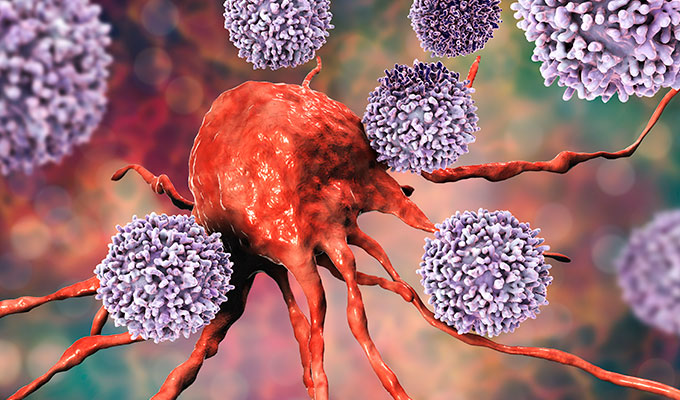Alone, or in combination with other therapies, Immuno-Oncology (I-O) appears currently as one of the most promising research fields to fight cancer. Nevertheless, developing breakthrough therapies to fully harness the immune system to fight diseased cells remain quite challenging.
To help researchers solve these hurdles, we have selected a complete offer of innovative and robust reagents and services. In this post, I wanted to highlight 6 Immuno-Oncology “must-haves” to facilitate your R&D projects.
#1- Biomarker antibody array
In humans, the identification of predictive biomarkers for cancer patient stratification is relatively difficult due to tumor heterogeneity. One way to easily overcome this issue is to use the Raybiotech antibody array that enables the profiling of 2000 human proteins. The protein targets belong to diverse protein families for a global overview of the possible new Biomarkets involved in your I-O project:

- Cytokines / Growth factors
- Metabolic enzymes
- Epigenetic markers
- Access the full list in this L2000 post.
With less than 150µL of serum/plasma, and without any complex sample extraction, it provides convenient access to a broad panel of human proteins to be “profiled” so that you can identify or validate predictive and specific biomarkers in cancer patient populations of interest.
tebu-bio laboratory services: Such biomarker profiling together with further quantification studies for validation, and data enrichment and biostatistics analysis can be performed in our laboratories recognized by Raybiotech as the European center of excellence for high-density array projects.
#2- Luciferase Reporter cell line
“Drug discovery is expanding beyond biochemical assay to include cellular assay”. Based on these observations BPS Bioscience have developed a broad offer of Luciferase Reporter cell lines composed by:

A) Co-Stimulatory Cell Lines
B) Reporter Cell Line
- Co-Stimulatory cell lines: Ideal ready-to-use cellular models to quickly assess the inhibitory effect of your compound on a specific Immune Checkpoint couple and to evaluate combination treatments. A few examples: PD-1 / PD-L1, TIGIT / CD155 …
- Reporter cell lines: These models enable the assessment of potential agonist or antagonist effects of your compound of interest on a particular target (e.g. OX40, GITR, HVEM..)

They will help you to confirm and complement the first screening results obtained by ELISA assay, in a more physiological context, increasing the success rate to identify relevant compounds for your in-vivo tests. As seen in figure 2, a broad list of Immune Checkpoint Cellular cellular models are already available.
As mentioned in my previous blog on I-O toolbox a full list of complementary products (ELISA assay, Recombinant proteins..) is available to complement your assays. Contact us to benefit from our rental program to test the cellular model at a lower price.
tebu-bio laboratory services: Our staff can perform ELISAs on your samples of interest but also develop the reporter cellular model matching your expectations and run the assay testings too.
#3- Reference inhibitor antibodies
Developing co-treatments in I-O (a majority of the recently FDA approved projects) and identifying the most effective combination remains difficult.
In addition to cellular reporter models above-discussed, tebu-bio gives you access to a full list of “Gold” standard antibodies for R&D applications:

- Anti-PD-1 Pembrolizumab (KEYTRUDA, Merck)
- Anti-CTLA4 Ipilimumab
(YERVOY, BMS) - Access to the
Used as simple control or in combination with other molecules, these standards will allow you to develop and test the best Immunotherapy combination and increase the clinical efficiency of your treatment. Take a look at the full list of IO antibodies for R&D applications.
tebu-bio laboratory service: Specific recombinant antibody production + Screening services
#4- Cancer marker expression Cell Lines
Engineering Lymphocytes to develop CAR-T cells model is a technical challenge. Assessing the capability of the model to bind to their target is also a major concern.
BPS Bioscience have developed for that purpose several cellular models with cancer markers expressed at different levels (fig. 3).

BCMA surface expression level (FACS analysis)
- BCMA CHO Recombinant Cell Line
- CD20 CHO Recombinant Cell Line
- HER2 (ERBB2) CHO Recombinant Cell Line
- and many other targets.
By mimicking differential antigen expression dependent on the tumor type and the cancer stage, these cellular models will allow you to evaluate the binding capability of your engineered CAR-T to a specific model.
Check our general post on CAR-T cell models, to see all our complementary CAR-T cell solutions.
tebu-bio laboratory services: Evaluation of binding capability of your CAR-T model + Development of custom cell line models + Production of specific cancer antigens.
#5- Interferons and Interleukins
Modulating Tumor MicroEnvironment (TME) can impact the efficiency of a specific treatment. tebu-bio give you access to a broad list of high-quality recombinant Cytokines (Interleukins and Interferons) to boost the Immune system, and elicit the best response for your treatments
Interested to monitor the Immune response after Immunomodulation? Take a look at our offer of Cytokine/inflammation multiplex assays.
tebu-bio laboratory service: Recombinant Interleukins and Interferons bulk production + Monitoring the Immune Response.
#6- mRNA Vaccines
Used in vaccines to encode and produce specific tumor-associated antigens (TAAs) to boost the immune system, mRNA as gain more and more interest as a potential treatment in I-O.
Thanks to our collaboration with the world leader company in custom mRNA production, we can offer you an unlimited list of mRNA :
- List of optimized mRNA for in-vitro transcription
- Optimized mRNA to decrease Immunogenicity (Clean Cap technology)
- Custom mRNA solutions
- CleanCap AU for self-amplyfying RNA (saRNA or self-replicating RNA)
Discover why the Clean cap technology can improve your mRNA vaccine model.



